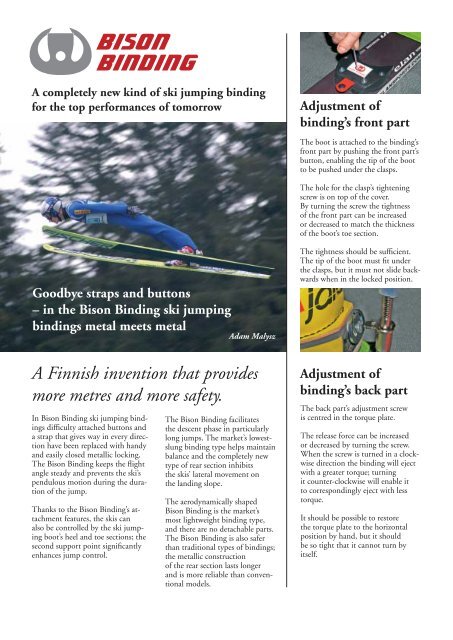in the Bison Binding ski jumping bindings metal ... - Low Bind Oy
in the Bison Binding ski jumping bindings metal ... - Low Bind Oy
in the Bison Binding ski jumping bindings metal ... - Low Bind Oy
Create successful ePaper yourself
Turn your PDF publications into a flip-book with our unique Google optimized e-Paper software.
A completely new k<strong>in</strong>d of <strong>ski</strong> jump<strong>in</strong>g b<strong>in</strong>d<strong>in</strong>gfor <strong>the</strong> top performances of tomorrowAdjustment ofb<strong>in</strong>d<strong>in</strong>g’s front partThe boot is attached to <strong>the</strong> b<strong>in</strong>d<strong>in</strong>g’sfront part by push<strong>in</strong>g <strong>the</strong> front part’sbutton, enabl<strong>in</strong>g <strong>the</strong> tip of <strong>the</strong> bootto be pushed under <strong>the</strong> clasps.The hole for <strong>the</strong> clasp’s tighten<strong>in</strong>gscrew is on top of <strong>the</strong> cover.By turn<strong>in</strong>g <strong>the</strong> screw <strong>the</strong> tightnessof <strong>the</strong> front part can be <strong>in</strong>creasedor decreased to match <strong>the</strong> thicknessof <strong>the</strong> boot’s toe section.Goodbye straps and buttons– <strong>in</strong> <strong>the</strong> <strong>Bison</strong> B<strong>in</strong>d<strong>in</strong>g <strong>ski</strong> jump<strong>in</strong>gb<strong>in</strong>d<strong>in</strong>gs <strong>metal</strong> meets <strong>metal</strong>Adam MalyszThe tightness should be sufficient.The tip of <strong>the</strong> boot must fit under<strong>the</strong> clasps, but it must not slide backwardswhen <strong>in</strong> <strong>the</strong> locked position.A F<strong>in</strong>nish <strong>in</strong>vention that providesmore metres and more safety.In <strong>Bison</strong> B<strong>in</strong>d<strong>in</strong>g <strong>ski</strong> jump<strong>in</strong>g b<strong>in</strong>d<strong>in</strong>gsdifficulty attached buttons anda strap that gives way <strong>in</strong> every directionhave been replaced with handyand easily closed <strong>metal</strong>lic lock<strong>in</strong>g.The <strong>Bison</strong> B<strong>in</strong>d<strong>in</strong>g keeps <strong>the</strong> flightangle steady and prevents <strong>the</strong> <strong>ski</strong>’spendulous motion dur<strong>in</strong>g <strong>the</strong> durationof <strong>the</strong> jump.Thanks to <strong>the</strong> <strong>Bison</strong> B<strong>in</strong>d<strong>in</strong>g’s attachmentfeatures, <strong>the</strong> <strong>ski</strong>s canalso be controlled by <strong>the</strong> <strong>ski</strong> jump<strong>in</strong>gboot’s heel and toe sections; <strong>the</strong>second support po<strong>in</strong>t significantlyenhances jump control.The <strong>Bison</strong> B<strong>in</strong>d<strong>in</strong>g facilitates<strong>the</strong> descent phase <strong>in</strong> particularlylong jumps. The market’s lowestslungb<strong>in</strong>d<strong>in</strong>g type helps ma<strong>in</strong>ta<strong>in</strong>balance and <strong>the</strong> completely newtype of rear section <strong>in</strong>hibits<strong>the</strong> <strong>ski</strong>s’ lateral movement on<strong>the</strong> land<strong>in</strong>g slope.The aerodynamically shaped<strong>Bison</strong> B<strong>in</strong>d<strong>in</strong>g is <strong>the</strong> market’smost lightweight b<strong>in</strong>d<strong>in</strong>g type,and <strong>the</strong>re are no detachable parts.The <strong>Bison</strong> B<strong>in</strong>d<strong>in</strong>g is also saferthan traditional types of b<strong>in</strong>d<strong>in</strong>gs;<strong>the</strong> <strong>metal</strong>lic constructionof <strong>the</strong> rear section lasts longerand is more reliable than conventionalmodels.Adjustment ofb<strong>in</strong>d<strong>in</strong>g’s back partThe back part’s adjustment screwis centred <strong>in</strong> <strong>the</strong> torque plate.The release force can be <strong>in</strong>creasedor decreased by turn<strong>in</strong>g <strong>the</strong> screw.When <strong>the</strong> screw is turned <strong>in</strong> a clockwisedirection <strong>the</strong> b<strong>in</strong>d<strong>in</strong>g will ejectwith a greater torque; turn<strong>in</strong>git counter-clockwise will enable itto correspond<strong>in</strong>gly eject with lesstorque.It should be possible to restore<strong>the</strong> torque plate to <strong>the</strong> horizontalposition by hand, but it shouldbe so tight that it cannot turn byitself.


